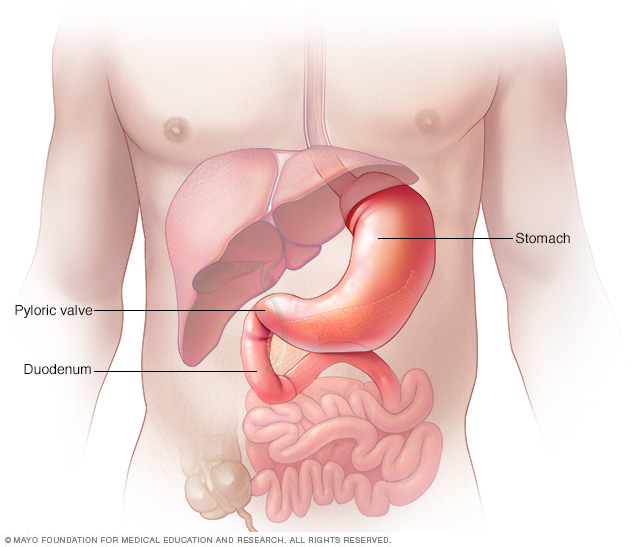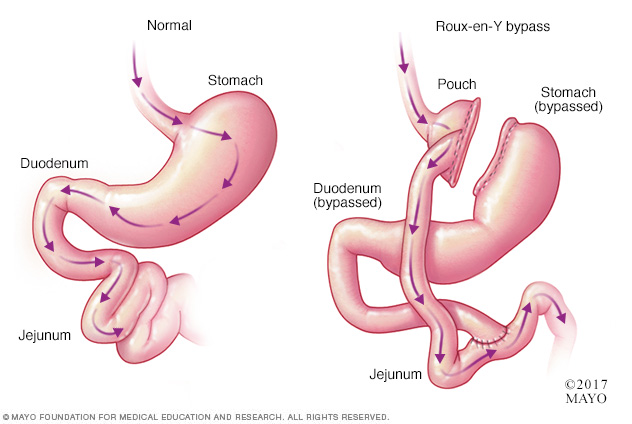Overview
Dumping syndrome is a condition in which food, especially food high in sugar, moves from your stomach into your small bowel too quickly after you eat. Sometimes called rapid gastric emptying, dumping syndrome most often occurs as a result of surgery on your stomach or esophagus.
Most people with dumping syndrome develop signs and symptoms, such as abdominal cramps and diarrhea, 10 to 30 minutes after eating. Other people have symptoms 1 to 3 hours after eating. And still others have both early and late symptoms.
Generally, you can help prevent dumping syndrome by changing your diet after surgery. Changes might include eating smaller meals and limiting high-sugar foods. In more-serious cases of dumping syndrome, you may need medications or surgery.
Products & Services
Symptoms
Signs and symptoms of dumping syndrome generally occur within minutes after eating, especially after a meal rich in table sugar (sucrose) or fruit sugar (fructose). They include:
- Feeling bloated or too full after eating
- Nausea
- Vomiting
- Abdominal cramps
- Diarrhea
- Flushing
- Dizziness, lightheadedness
- Rapid heart rate
Late dumping syndrome starts 1 to 3 hours after you eat a high-sugar meal. It takes time for signs and symptoms to develop because after you eat your body releases large amounts of insulin to absorb the sugars entering your small intestine. The result is low blood sugar.
Signs and symptoms of late dumping syndrome can include:
- Sweating
- Flushing
- Dizziness, lightheadedness
- Weakness
- Rapid heart rate
Some people have both early and late signs and symptoms. And dumping syndrome can develop years after surgery.
When to see a doctor
Contact your health care provider if any of the following apply to you.
- You develop signs and symptoms that might be due to dumping syndrome, even if you haven't had surgery.
- Your symptoms are not controlled by dietary changes.
- You are losing large amounts of weight due to dumping syndrome. Your doctor may refer you to a registered dietitian to help you create an eating plan.
Causes
Stomach and pyloric valve

Stomach and pyloric valve
Your stomach is a muscular sac about the size of a small melon that expands when you eat or drink. It holds as much as a gallon (3.8 liters) of food or liquid. Once your stomach breaks down the food, strong muscular contractions known as peristaltic waves push the food toward the pyloric valve. This valve leads to the upper portion of your small intestine, a segment known as the duodenum.
In dumping syndrome, food and gastric juices from your stomach move to your small intestine in an uncontrolled, abnormally fast manner. This is most often related to changes in your stomach associated with surgery, including any stomach surgery or major esophageal surgery, such as removal of the esophagus (esophagectomy). But in rare cases, dumping syndrome can develop without a history of surgery or other obvious causes.
Risk factors
Gastric bypass surgery

Gastric bypass surgery
Before gastric bypass, food (see arrows) enters your stomach and passes into the small intestine. After surgery, the amount of food you can eat is reduced due to the smaller stomach pouch. Food is also redirected so that it bypasses most of your stomach and the first section of your small intestine (duodenum). Food flows directly into the middle section of your small intestine (jejunum), limiting the absorption of calories.
Surgery that alters your stomach can increase your risk of dumping syndrome. These surgeries are most commonly performed to treat obesity, but are also part of treatment for stomach cancer, esophageal cancer and other conditions. These surgeries include:
- Bariatric surgery — especially gastric bypass surgery (Roux-en-Y operation) or sleeve gastrectomy — which is performed to treat morbid obesity.
- Gastrectomy, in which a portion or all of your stomach is removed.
- Esophagectomy, in which all or part of the tube between the mouth and the stomach is removed.
- Fundoplication, a procedure used to treat gastroesophageal reflux disease (GERD) and hiatal hernia
- Vagotomy, a type of surgery to treat stomach ulcers.
- Pyloroplasty, which is done to widen the valve to the stomach (pylorus), allowing food to pass through.